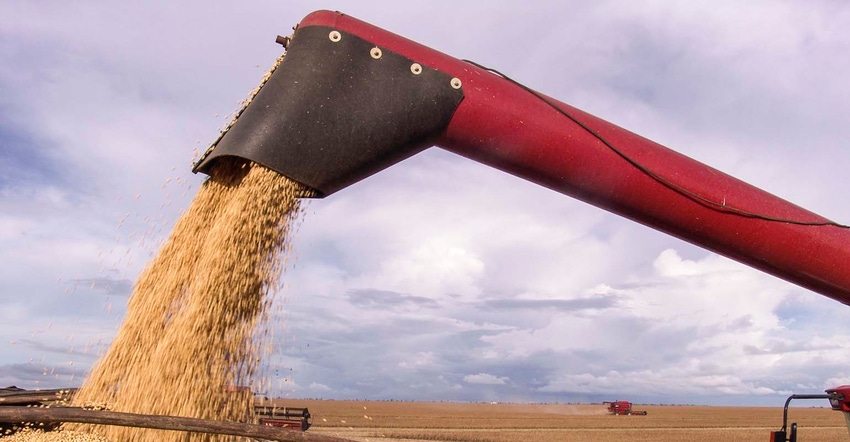
by Lydia Mulvany
For Pete Zimmerman, a Minnesota farmer, the age of gene-edited foods has arrived. While he couldn’t be happier, the hi-tech soybeans he’s now harvesting are at the crux of a long-running debate about a frankenfood future.
Zimmerman is among farmers in three states now harvesting 16,000 acres of DNA-altered soybeans destined to be used in salad dressings, granola bars and fry oil, and sold to consumers early next year. It’s the first commercialized crop created with a technique some say could revolutionize agriculture, and others fear could carry as-yet unknown peril.
In March, the top U.S. regulator said no new rules or labeling are needed for gene-edited plants since foreign DNA isn’t being inserted, the way traditional genetically modified organisms, or GMOs, are made. Instead, enzymes that act like scissors are used to tweak a plant’s genetic operating system to stop it from producing bad stuff -- in this case, polyunsaturated fats -- or enhance good stuff that’s already there.
While that seems a win-win, “you don’t know what those mutations or rearrangements might do in a plant,” said Michael Hansen, a senior scientist at the Consumers Union. He wants the plants tested for safety before they’re marketed, and clearly labeled once they’re sold.
Tinkering with plant genes could lead to unplanned deletions or complex genetic rearrangements that cause “unintended consequences” within the food chain, he said.
The Trump administration, however, disagrees. In a March 28 statement, Agriculture Secretary Sonny Perdue said his department has no plans to regulate new plant varieties developed with gene editing, countering a European Union decision to designate the technique as producing GMO crops.
In his statement, Perdue called gene-editing an “innovative” technique that’s “indistinguishable from those developed through traditional breeding methods.”
The end result: Gene-edited plants can be developed and marketed in the U.S. much more quickly and at less cost than GMOs that blend DNA from different plant varieties, a highly regulated technique with mandated field trials that can take a decade or more to develop.
That’s allowed the Minnesota-based biotech firm Calyxt Inc. to get its soybeans into the market within five years from the time Dan Voytas, the company’s science chief and co-founder, altered the DNA in a single soybean cell in 2012 using an enzyme called TALEN he helped develop at the University of Minnesota.
After the harvest is done, the soybeans will be crushed for their oil, then sold to food companies. The goal: Consumers get less heart-threatening fats from a product that’s widely used in a variety of food products, locally grown and can be traced back to the county where it was produced, said Manoj Sahoo, Calyxt’s chief commercial officer.
Gene-edited foods don’t need to be labeled, but Sahoo says food companies using the soybean oil will be able to make health claims on packaging like zero trans fats, and even non-GMO.
Calyxt is now in discussions with about 20 companies that are potential buyers, Sahood said, adding that the company expects to sell its first harvest on an as-needed basis to anywhere from two to five of those companies.
Zach Luttrell, a principal at industry consultant StraightRow LLC, sees gene-editing as a way for the industry to continue lowering costs. A product developed using the new technique could be brought to market within three years, costing about $10 million to $20 million, he said, comparing it with a GMO product that could cost $100 million over a decade.
“Agriculture has historically been dominated by a few huge players, but now much smaller companies will be able to pop up and develop these new crops,” Luttrell said. “In the future we will truly have designer crops.”
An Economic Decision
Zimmerman’s decision to plant a few hundred acres of the altered soybeans on his 3,000-acre was primarily economic, he said. Farmers growing the crops will gain anywhere from 40 to 90 cents a bushel over standard futures prices, said Charles Baron, co-founder of Farmer’s Business Network Inc. The company, whose member farms represent 26 million acres in the U.S. and Canada, helped Calyxt recruit growers and financed farmers purchasing the seeds.
However, there is some extra work involved, he said. The crop requires different pesticides and has to be stored separately. He also had to thoroughly clean out his harvesting equipment, semi-trucks and storage bins to ensure no contamination from existing crops.
Still, the 55-year-old farmer said he’s happy he made the effort. “They’ve been our best-looking beans all year, they really have,” Zimmerman said. If the pricing contract is similar next year, he’ll do it again, he said.
Calyxt isn’t alone in the field. Swiss-based Syngenta AG is looking to bring its first gene-edited products to the market early next decade, and is applying the technique to crops like tomatoes, rice and sunflowers. Arcadia Biosciences Inc., based in Davis, California, is another company actively using gene-editing to come up with consumer-friendly foods.
Even with the Calyxt harvest, it’s not even early innings for gene-editing, said John Dombrosky, chief executive officer of AgTech Accelerator, a North Carolina-based consortium of venture capital firms that invests in agriculture startups.
“We’re just driving to the ball park,” Dombrosky said in a telephone interview. Gene-editing “will be set free to do tremendous things across the ag continuum, and the promise is just gigantic. We’ll be able to fine-tune food for amazing health and nutrition benefits.”
--With assistance from Deena Shanker, Lucca de Paoli and Isis Almeida.
To contact the reporter on this story: Lydia Mulvany in Chicago at [email protected]
To contact the editors responsible for this story: James Attwood at [email protected] Reg Gale, Will Wade
© 2018 Bloomberg L.P
About the Author(s)
You May Also Like




